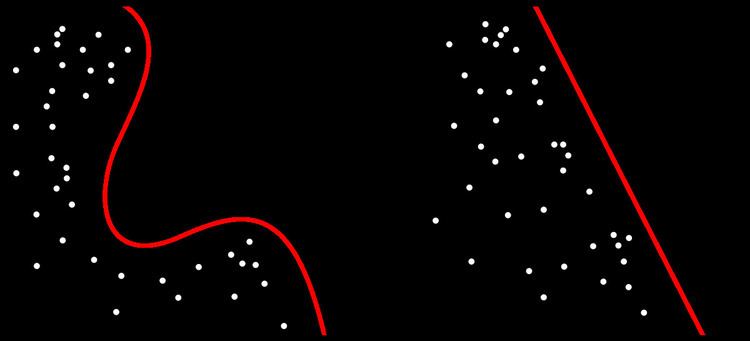 | ||
In machine learning, kernel methods are a class of algorithms for pattern analysis, whose best known member is the support vector machine (SVM). The general task of pattern analysis is to find and study general types of relations (for example clusters, rankings, principal components, correlations, classifications) in datasets. For many algorithms that solve these tasks, the data in raw representation have to be explicitly transformed into feature vector representations via a user-specified feature map: in contrast, kernel methods require only a user-specified kernel, i.e., a similarity function over pairs of data points in raw representation.
Contents
- Motivation and informal explanation
- Mathematics the kernel trick
- Applications
- Popular kernels
- References
Kernel methods owe their name to the use of kernel functions, which enable them to operate in a high-dimensional, implicit feature space without ever computing the coordinates of the data in that space, but rather by simply computing the inner products between the images of all pairs of data in the feature space. This operation is often computationally cheaper than the explicit computation of the coordinates. This approach is called the "kernel trick". Kernel functions have been introduced for sequence data, graphs, text, images, as well as vectors.
Algorithms capable of operating with kernels include the kernel perceptron, support vector machines (SVM), Gaussian processes, principal components analysis (PCA), canonical correlation analysis, ridge regression, spectral clustering, linear adaptive filters and many others. Any linear model can be turned into a non-linear model by applying the kernel trick to the model: replacing its features (predictors) by a kernel function.
Most kernel algorithms are based on convex optimization or eigenproblems and are statistically well-founded. Typically, their statistical properties are analyzed using statistical learning theory (for example, using Rademacher complexity).
Motivation and informal explanation
Kernel methods can be thought of as instance-based learners: rather than learning some fixed set of parameters corresponding to the features of their inputs, they instead "remember" the
where
Kernel classifiers were described as early as the 1960s, with the invention of the kernel perceptron. They rose to great prominence with the popularity of the support vector machine (SVM) in the 1990s, when the SVM was found to be competitive with neural networks on tasks such as handwriting recognition.
Mathematics: the kernel trick
The kernel trick avoids the explicit mapping that is needed to get linear learning algorithms to learn a nonlinear function or decision boundary. For all
Certain problems in machine learning have additional structure than an arbitrary weighting function
The key restriction is that
Mercer's theorem is akin to a generalization of the result from linear algebra that associates an inner product to any positive-definite matrix. In fact, Mercer's condition can be reduced to this simpler case. If we choose as our measure the counting measure
If this summation holds for all finite sequences of points
Some algorithms that depend on arbitrary relationships in the native space
Theoretically, a Gram matrix
If the kernel function
Finally, suppose that
Applications
Application areas of kernel methods are diverse and include geostatistics, kriging, inverse distance weighting, 3D reconstruction, bioinformatics, chemoinformatics, information extraction and handwriting recognition.
